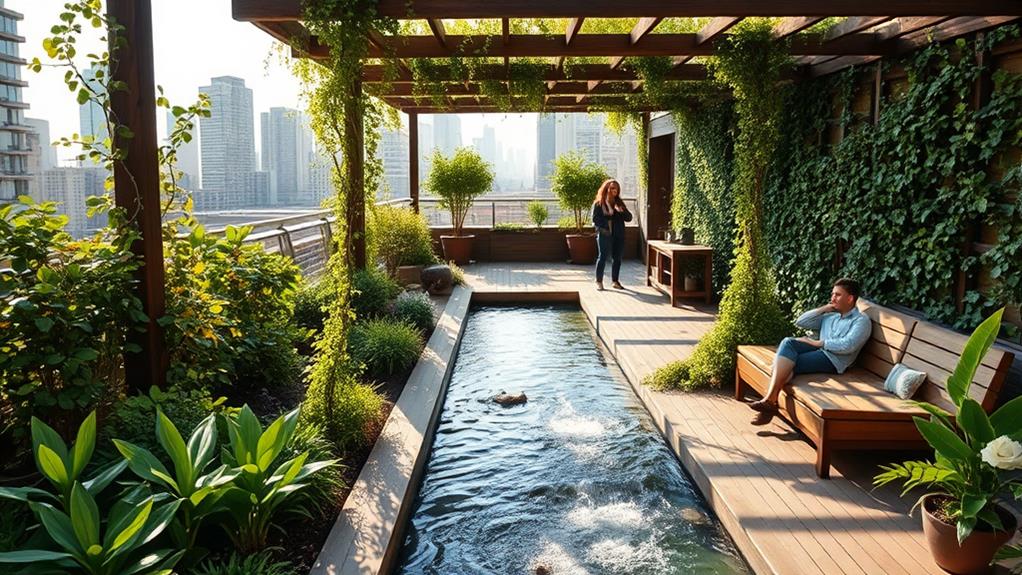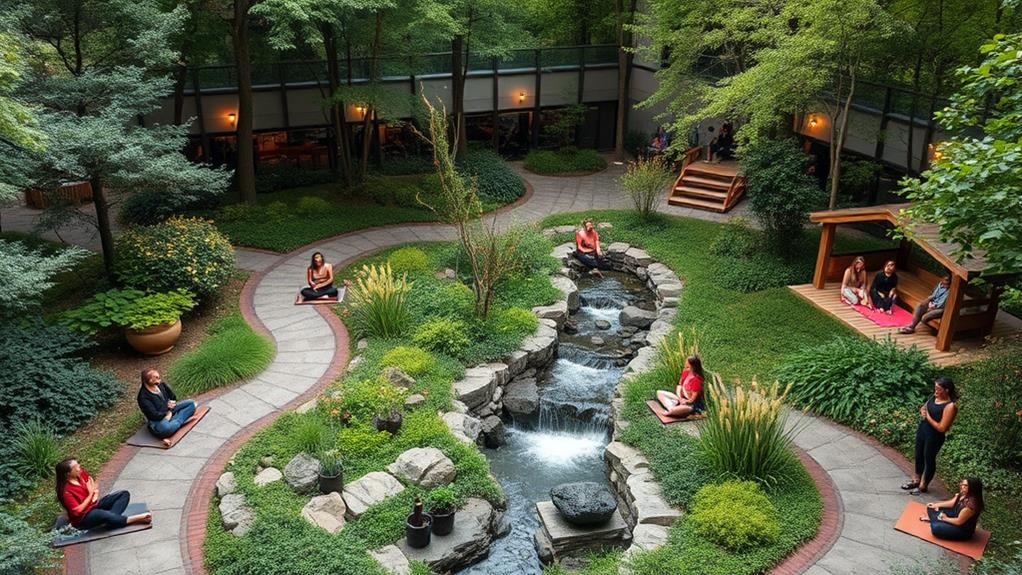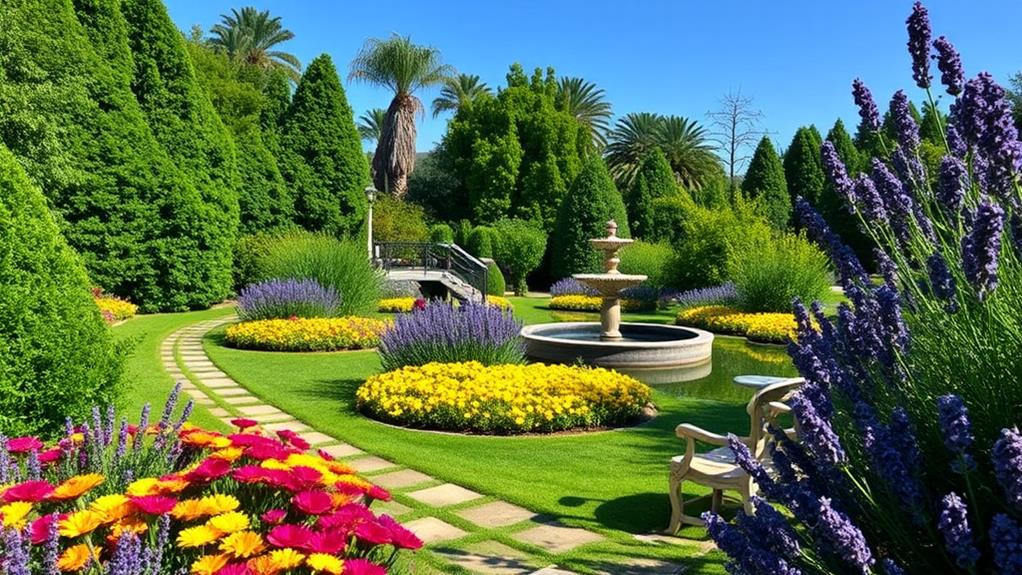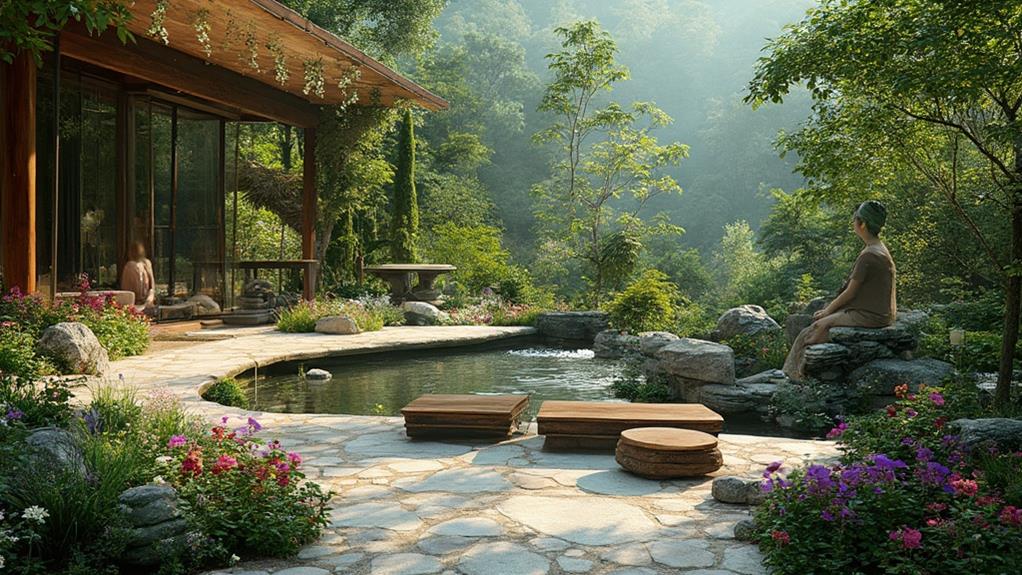The psychology of outdoor spaces focuses on creating environments that promote mental health and overall wellbeing. Key principles include incorporating biophilic design elements, fostering social interaction, and utilizing color psychology. Designers aim to create restorative environments by integrating natural elements, optimizing sensory experiences, and balancing privacy with openness. Accessibility and inclusive design ensure that outdoor spaces cater to diverse user needs. By understanding how environmental factors influence human psychology, landscape architects can craft spaces that reduce stress, improve mood, and enhance cognitive function. Exploring these design strategies reveals the profound impact thoughtful outdoor spaces can have on our mental and emotional states.
Biophilic Design Principles

Biophilic design principles incorporate natural elements and patterns into built environments to foster human connection with nature. This approach recognizes the innate human affinity for natural systems and processes, aiming to improve wellbeing, productivity, and overall quality of life. Key principles include direct experiences of nature, such as plants, water features, and natural light, as well as indirect experiences through natural materials, textures, and patterns.
Implementing biophilic design in outdoor spaces involves creating diverse ecosystems, using native plants, and incorporating natural landforms. Water elements, like ponds or streams, can provide both visual and auditory stimulation. Natural materials like wood and stone should be used for pathways, seating, and structures. Designers should also consider the changing seasons and local climate to create year-round interest and comfort.
Biophilic design extends beyond aesthetics, addressing functional aspects such as air quality, thermal comfort, and acoustic properties. By mimicking natural systems, outdoor spaces can provide shelter, shade, and ventilation. Additionally, incorporating elements that attract local wildlife, such as bird feeders or pollinator gardens, can further enhance the connection between humans and nature in these designed environments.
Nature's Impact on Mental Health
Numerous studies have demonstrated the profound impact of nature on mental health and overall psychological wellbeing. Exposure to natural environments has been shown to reduce stress, anxiety, and depression while improving mood, cognitive function, and self-esteem. Research indicates that even brief encounters with nature, such as viewing green spaces from a window or spending time in urban parks, can have significant positive effects on mental health.
The restorative properties of nature are attributed to several factors. Natural settings provide a sense of escape from daily stressors and allow for mental recuperation. The visual complexity of natural landscapes captures attention effortlessly, promoting a state of "soft fascination" that allows the mind to rest and recharge. Additionally, exposure to nature has been linked to decreased rumination, a cognitive process associated with depression and anxiety.
Incorporating natural elements into urban and indoor environments through biophilic design can help bring these mental health benefits to individuals who may have limited access to nature. This approach can include integrating plants, natural materials, and nature-inspired forms and patterns into architectural and interior design, creating spaces that support psychological wellbeing and resilience.
Creating Restorative Environments

With the understanding that nature profoundly impacts mental health, designers and architects are increasingly focused on creating restorative environments that harness these benefits. These spaces are intentionally designed to reduce stress, promote relaxation, and enhance overall well-being. Key elements of restorative environments include natural light, vegetation, water features, and views of nature.
Biophilic design principles are often employed to create these environments, incorporating natural materials, patterns, and textures that mimic the outdoors. This approach can be applied to both indoor and outdoor spaces, from urban parks to office interiors. Designers also consider factors such as air quality, acoustics, and thermal comfort to optimize the restorative potential of a space.
The creation of restorative environments extends beyond aesthetics, focusing on functionality and user experience. Spaces are designed to encourage mindfulness, social interaction, and physical activity. Features like walking paths, meditation areas, and community gardens are integrated to promote diverse wellness activities. By thoughtfully combining these elements, designers can create environments that not only look beautiful but actively contribute to the mental and physical health of their occupants.
Social Interaction in Outdoor Spaces
Outdoor spaces regularly serve as vital hubs for social interaction, fostering community connections and promoting mental well-being. These environments provide opportunities for both planned and spontaneous encounters, allowing individuals to engage with others in a natural setting. Well-designed outdoor spaces can encourage social cohesion by incorporating features that facilitate conversation and shared activities.
Key elements for promoting social interaction include seating arrangements that face each other, communal areas for group activities, and multi-functional spaces that cater to diverse interests. Designers should consider creating "social triangles" – strategically placed seating or activity nodes that naturally draw people together. Additionally, incorporating elements like community gardens, outdoor chess tables, or fitness equipment can serve as conversation starters and shared focal points.
The layout of outdoor spaces should also accommodate various group sizes and privacy levels, allowing for both intimate conversations and larger gatherings. Thoughtful landscaping can create semi-private nooks while maintaining open sightlines. By designing outdoor spaces that prioritize social interaction, urban planners and landscape architects can contribute significantly to community building and individual well-being, creating environments that nurture human connections and social support networks.
Color Psychology in Landscape Design

Beyond the physical layout of outdoor spaces, the strategic use of color plays a significant role in landscape design and its impact on human well-being. Color psychology in landscape architecture harnesses the emotional and psychological effects of different hues to create specific moods and experiences.
Cool colors like blues and greens tend to evoke feelings of calmness and tranquility, making them ideal for meditation gardens or relaxation areas. Warm colors such as reds, oranges, and yellows can stimulate energy and excitement, suitable for playgrounds or social gathering spaces.
Landscape designers must consider the interplay between colors in plants, hardscaping elements, and architectural features to create harmonious or contrasting effects. The careful selection of flower colors, foliage textures, and seasonal changes can guide the eye through a space and create visual interest.
Additionally, color can be used to influence perception of space, with lighter hues making areas appear larger and darker tones creating a sense of intimacy. By understanding and applying color psychology principles, landscape architects can design outdoor environments that not only please the eye but also positively influence mood, behavior, and overall well-being.
Sensory Elements and Wellbeing
Sensory engagement forms the cornerstone of holistic landscape design, extending far beyond visual appeal to encompass all five senses. By incorporating elements that stimulate touch, smell, sound, and even taste, designers can create environments that promote wellbeing and foster a deeper connection with nature.
Tactile experiences can be enhanced through the use of varied textures in pathways, seating areas, and plant selections. Smooth river stones, rough bark, and soft grass provide diverse sensations underfoot and to the touch. Fragrant plants like lavender, jasmine, and herbs not only please the olfactory sense but can also evoke memories and emotions.
The strategic placement of water features, wind chimes, or carefully selected plants that rustle in the breeze adds auditory interest, creating a soothing soundscape that can mask urban noise and reduce stress.
Edible landscaping, incorporating fruit trees or herb gardens, engages the sense of taste and encourages interaction with the environment. By thoughtfully combining these sensory elements, landscape designers can create immersive outdoor spaces that nurture mental and physical wellbeing, providing a multifaceted experience that resonates on a deeper, more instinctual level with users.
Balancing Privacy and Openness

While sensory elements create immersive experiences, the spatial arrangement of a landscape plays a key role in promoting wellbeing. Balancing privacy and openness in outdoor spaces is crucial for fostering a sense of comfort and security while maintaining social connectivity. Designers must consider the psychological needs of users, incorporating both secluded areas for reflection and open spaces for interaction.
Private nooks, such as secluded seating areas or enclosed gardens, offer refuge from overstimulation and allow for personal restoration. These spaces can be created using natural barriers like vegetation, subtle changes in elevation, or architectural elements.
Conversely, open areas facilitate social engagement and community building, essential for mental health. Communal spaces, like central lawns or gathering plazas, encourage spontaneous interactions and group activities.
The key lies in creating a harmonious transition between private and public zones. Gradual shifts in spatial definition, such as semi-private buffer zones or permeable boundaries, allow users to control their level of engagement. By offering a range of spatial experiences, from intimate to expansive, designers can cater to diverse psychological needs and preferences, ultimately enhancing the overall wellbeing of visitors in outdoor environments.
Accessibility and Inclusive Design
As landscape architects strive to create spaces that promote wellbeing for all, accessibility and inclusive design emerge as critical considerations. These principles ensure that outdoor environments can be enjoyed by people of diverse abilities, ages, and backgrounds. Inclusive design goes beyond basic accessibility requirements, aiming to create spaces that are inherently usable by the widest possible range of individuals without the need for adaptation or specialized design.
Key elements of accessible and inclusive outdoor spaces include level or gently sloped pathways, appropriate lighting, clear signage, and strategically placed seating areas. Designers must consider the needs of those with mobility impairments, visual or hearing disabilities, and cognitive differences. Sensory gardens, tactile elements, and auditory features can enhance the experience for all users while providing specific benefits for those with sensory processing challenges.
Inclusive design also addresses cultural sensitivity and intergenerational use. By incorporating diverse cultural references and creating spaces that appeal to various age groups, landscape architects can foster a sense of belonging and community engagement. This approach not only improves the physical accessibility of spaces but also enhances their social and emotional accessibility, contributing to overall wellbeing for a broader population.
Frequently Asked Questions
How Does Climate Affect the Psychological Impact of Outdoor Spaces?
Climate significantly influences the psychological impact of outdoor spaces. Temperature, sunlight, humidity, and precipitation affect comfort levels, mood, and overall well-being. Extreme conditions can deter usage, while pleasant climates encourage outdoor activities and social interactions.
What Role Does Personal Cultural Background Play in Outdoor Space Preferences?
Cultural roots run deep in outdoor space preferences. Personal background shapes expectations, comfort levels, and aesthetic appreciation. From Zen gardens to English cottage landscapes, individuals often gravitate towards designs that resonate with their cultural heritage.
Can Virtual Reality Replicate the Psychological Benefits of Real Outdoor Environments?
Virtual reality can partially replicate psychological benefits of real outdoor environments, offering visual and auditory stimuli. However, it lacks full sensory immersion, physical exertion, and natural elements that contribute to the holistic benefits of actual outdoor experiences.
How Do Night-Time Outdoor Spaces Influence Psychological Wellbeing Differently From Daytime Spaces?
Night-time outdoor spaces influence psychological wellbeing differently by altering perception, inducing calmness, and stimulating introspection. Reduced visual stimuli, cooler temperatures, and the presence of celestial bodies contribute to a unique sensory experience, potentially enhancing relaxation and contemplation.
What Are the Long-Term Effects of Regular Exposure to Well-Designed Outdoor Spaces?
Like a soothing balm for the mind, regular exposure to well-designed outdoor spaces can yield long-term benefits. These include reduced stress levels, improved cognitive function, enhanced mood, increased physical activity, and stronger social connections among community members.
Conclusion
The psychology of outdoor spaces plays a crucial role in designing environments that promote wellbeing. By incorporating biophilic design principles, considering nature's impact on mental health, and creating restorative environments, designers can significantly enhance human experiences. For example, the High Line in New York City transformed an abandoned railway into a thriving urban park, demonstrating how thoughtful outdoor design can foster social interaction, engage the senses, and improve overall quality of life. Ultimately, well-designed outdoor spaces have the power to positively influence mental health and community wellbeing.

